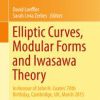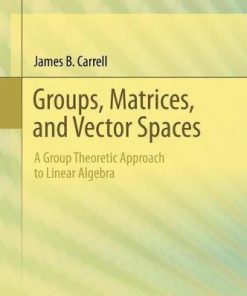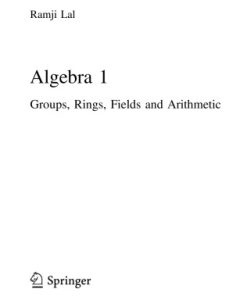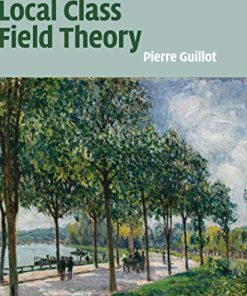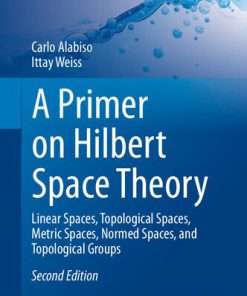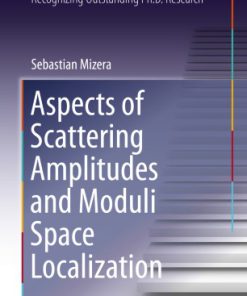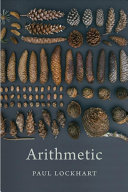Brauer Groups and Obstruction Problems Moduli Spaces and Arithmetic 1st Edition by Asher Auel, Brendan Hassett, Anthony Varilly Alvarado, Bianca Viray ISBN 9783319468525 3319468529
$50.00 Original price was: $50.00.$25.00Current price is: $25.00.
Brauer Groups and Obstruction Problems Moduli Spaces and Arithmetic 1st Edition by Asher Auel, Brendan Hassett, Anthony Varilly Alvarado, Bianca Viray – Ebook PDF Instant Download/Delivery: 9783319468525 ,3319468529
Full download Brauer Groups and Obstruction Problems Moduli Spaces and Arithmetic 1st Edition after payment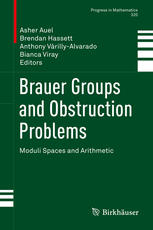
Product details:
ISBN 10: 3319468529
ISBN 13: 9783319468525
Author: Asher Auel, Brendan Hassett, Anthony Varilly Alvarado, Bianca Viray
Brauer Groups and Obstruction Problems Moduli Spaces and Arithmetic 1st Edition Table of contents:
Twisted Derived Equivalences for Affine Schemes
1. Introduction
2. Twisted derived categories
3. Twisted derived equivalences over affine schemes
References
Rational Points on Twisted K3 Surfaces and Derived Equivalences
1. Introduction
Acknowledgements
2. Construction of the twisted K3 surfaces
2.1. Quadric fibrations
2.2. Twisted K3 surfaces
3. Derived equivalence of the twisted K3 surfaces
3.1. Conventions
3.2. Semiorthogonal decompositions
3.3. Derived categories of quadric fibrations
3.4. Derived equivalence
4. Equations for the twisted K3 surfaces and local invariants
4.1. Equations for the twisted K3 surfaces
4.2. Conditions controlling the local invariants
5. Proof of Theorem 1.2
5.1. Example over Q
5.2. Example over Q2
5.3. Example over R
5.4. Proof of Proposition 5.2
5.4.1. Local points
5.4.2. Local invariants
References
Universal Unramified Cohomology of Cubic Fourfolds Containing a Plane
Introduction
1. Unramified cohomology and Chow group of 0-cycles
1.1. Unramified elements
1.2. Chow groups of 0-cycles
1.3. Connections with complex geometry
2. Chow groups of 0-cycles on cubic hypersurfaces
3. Unramified cohomology of quadrics
4. Cubic fourfolds containing a plane and Clifford algebras
5. Proof of the main result
References
Universal Spaces for Unramified Galois Cohomology
Introduction
Acknowledgments
1. Stable cohomology
2. Central extensions and isoclinism
3. Basic valuation theory
4. Liftable subgroups and their con�gurations
5. Galois cohomology of function �elds
6. Unramified cohomology
7. Main theorem
8. The smooth case
9. Reduction to the smooth case
References
Rational Points on K3 Surfaces and Derived Equivalence
1. Generalities on derived equivalence for K3 surfaces
1.1. Definitions
1.2. Mukai lattices
1.3. Characterizations over the complex numbers
1.4. Descending derived equivalence
1.5. Cycle-theoretic invariants of derived equivalence
2. Examples of derived equivalence
2.1. Elliptic fibrations
2.2. Rank one K3 surfaces
2.3. Rank two K3 surfaces
3. Finite and real fields
4. Geometric case: local fields with complex residue field
5. Semistable models over p-adic fields
Appendix: Semistability and derived equivalence
References
Unramified Brauer Classes on Cyclic Covers of the Projective Plane
1. Introduction
1.1. Related work and open questions
1.1.1. Pulling back Brauer classes
1.1.2. Symmetric resolutions of line bundles
1.2. Notation
1.3. Outline
Acknowledgements
2. Background on the Brauer group and Clifford algebras
2.1. Cyclic algebras
2.2. Residues of Brauer elements
2.3. Symbols and residues of Clifford algebras
3. Preliminaries on p-cyclic covers
3.1. Geometric invariants of X
3.2. The cyclic action on the Brauer group
4. p-torsion divisor classes and Brauer elements
4.1. Divisor classes on C
4.2. Obtaining Brauer elements on X
4.3. Surjectivity of
4.4. Obtaining elements of (PicC=ZL) [p] from divisors on X
4.5. Proof of Theorem 1.3
4.6. Alternative proof of surjectivity when p = 2
5. Geometric constructions for Brauer elements in the case p = 2
5.1. Symmetric resolution on line bundles
5.2. Constructing Brauer classes
6. Compatibility of and AX
6.1. Residues of AU(L)
6.2. Symmetric matrices of homogeneous forms on P2
6.3. Determining the Weil divisor corresponding to L
6.4. Proof of Theorem 6.1
7. Degree 2 K3 surfaces
7.1. 6=6
7.2. 6 = 4 + 2
7.3. 6=2+2+2
7.4. 6 = 5 + 1
7.5. 6=3+3
7.6. 6 = 3 + 1 + 1 + 1
7.7. 6=1+1+1+1+1+1
Appendix A. Combinatorics of Proposition 5.3 (by Hugh Thomas)
References
Arithmetically Cohen{Macaulay Bundles on Cubic Fourfolds Containing a Plane
Introduction
The result
Related works
Plan of the paper
Notation
1. Preliminaries
1.1. Semiorthogonal decompositions
1.2. ACM bundles on cubics
1.3. Geometry of cubic fourfolds with a plane
1.4. The derived category of the associated K3 surface
2. A family of sheaves on cubic fourfolds containing a plane
Step 1: Kuznetsov’s embedding
Step 2: the right mutation
Step 3: the left mutation
Step 4: the blow-up
3. A family of stable ACM vector bundles
Step 1: ACM bundle
Step 2: Gieseker stability
3.1. Universal family
Acknowledgements
References
Brauer Groups on K3 Surfaces and Arithmetic Applications
1. Introduction
Classification of order p subgroups of general K3 surfaces
Geometric realization of Mukai dualities
Explicit obstructions to weak approximation
Acknowledgements
2. Lattice gymnastics
2.1. Set-up
2.2. Discriminant groups of p-torsion Brauer classes
2.3. Isomorphism classes of lattices
2.4. Counting lattices
2.5. Summary
2.6. Lattice theory for Mukai dual K3 surfaces
2.7. Special Cubic fourfolds
3. Mukai dual K3 surfaces
3.1. Set-up
3.2. The degree eight/degree two duality
3.3. The degree eighteen/degree two duality
3.4. The degree sixteen/degree four duality
4. Other dualities
5. Application: Failure of weak approximation
5.1. Quadratic forms of rank 6 and the even Clifford algebras
5.2. Brauer-Manin obstructions
5.3. Local invariants at the real place
5.4. An explicit example
5.5. What about the Hasse principle?
References
On a Local-Global Principle for H3 of Function Fields of Surfaces over a Finite Field
1. Introduction
2. Classification of the ramification points, complements on ’hot’ points
2.1. Notations and first properties
2.1.1. Residues and unramified cohomology
2.1.2. Function fields of surfaces over a finite field
2.2. Classification of points
2.3. Local description
3. The local-global principle
3.1. Additional notations
3.2. Plan of the proof
3.3. Analyzing curves and points in the ramification divisor
3.3.1. Local description at nodal points
3.3.2. First choice of f
3.3.3. A better choice of f
3.4. Adjusting term for other curves
3.4.1. End of the proof of theorem 1.1
References
Cohomology and the Brauer Group of Double Covers
1. Introduction
2. Cyclic covers
3. Cohomology of double covers
4. Surfaces
4.1. Cohomology of double covers of surfaces
4.2. Proof of Theorem 1.1
4.3. Surfaces to which the theorem can be applied
References
People also search for Brauer Groups and Obstruction Problems Moduli Spaces and Arithmetic 1st Edition:
brauer manin obstruction
brauer construction
problems in group theory
unsolved problems in group theory
Tags:
Asher Auel,Brendan Hassett,Anthony Varilly Alvarado,Bianca Viray,Brauer Groups,Obstruction Problems
You may also like…
Mathematics - Functional Analysis
Mathematics - Symmetry and group
Romance - Paranormal Romance
Mathematics
Groups Matrices and Vector Spaces A Group Theoretic Approach to Linear Algebra James B. Carrell
Mathematics - Algebra
Algebra 1 Groups Rings Fields and Arithmetic 1st Edition Ramji Lal
Mathematics - Number Theory
Mathematics - Functional Analysis
Mathematics - Mathematical Physics
Aspects of Scattering Amplitudes and Moduli Space Localization Sebastian Mizera


